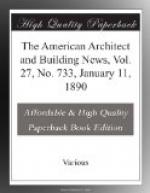It may now be said: “Yes, this is all true, but we have changed all that! We no longer inter our dead in churchyards or burial-grounds within the limits of cities. We have provided cemeteries at great distances from our cities and large centres of population, and there the dead can do no harm.”
To this the reply is easy and convincing: “that, if the dead endanger the living when the population is dense, they certainly also endanger them when the population is sparse. The danger is only diluted. It still exists, and it ought to alarm us just as truly when a few are imperilled as when many are.” ...
Not to attempt to tell all that has been ascertained, it will be sufficiently convincing to quote from Sir Henry Thompson’s utterance in the Nineteenth Century in 1880: “I state, as a fact of the highest importance, that, by burial in earth, we effectively provide—whatever sanitary precautions are taken by ventilation and drainage, whatever disinfection is applied after contagion has occurred—that the pestilential germs, which have destroyed the body in question, are thus so treasured and protected as to propagate and multiply, ready to reappear and work like ruin hereafter for others.... Beside anthrax or splenic fever, spores from which are notoriously brought to the surface from buried animals below, and become fatal to the herds feeding there, it is now almost certain that malarial diseases, notably Roman fever and even tetanus, are due to bacteria which flourish in the soil itself. The poisons of scarlet fever, enteric fever (typhoid), small-pox, diphtheria and malignant cholera are undoubtedly transmissible through earth from the buried body.” That the burial of a body that contains the seeds of zymotic disease is simply storing them for future reproduction and destruction is amply proved by the researches of Darwin and Pasteur, of whom the former has shown that the mould, or fertile upper layer of superficial soil, has largely acquired its character by its passage through the digestive tract of earth-worms; and the latter that this mould, when brought by this agency to the surface from subjacent soil that has been used as a grave, contains the specific germ of the disease that has destroyed its tenant.
It may now be asked: “Granting that these evils are inseparable from the burial of the dead in the earth or in tombs, what is the remedy? What else can be done?”
To this question not many answers can be given, because the modes of disposing of the dead have always been and must always be few.
Plainly, no such novel mode as casting the dead into the sea will be generally adopted. Plainly, also, the mode of the Parsees, grounded as it is in ancient, if not original use—to give the dead to beasts and birds—will not become universal. And, plainly also, cremation will not be welcome to the many, free as it is from objection on the score of public health, if a method equally sanitary, and at the same time satisfactory to a reverent and tender sentiment, can be devised.




